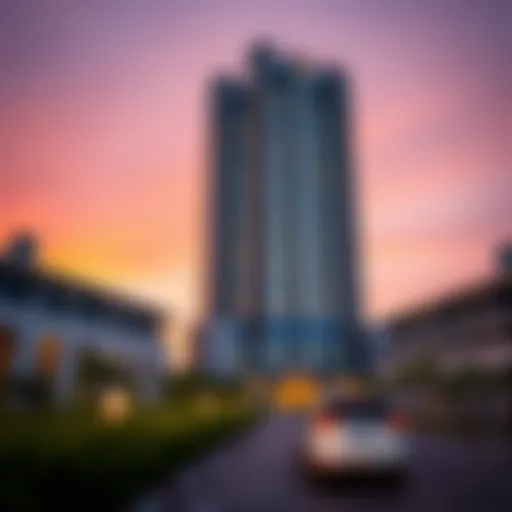Exploring Nad Al Sheba Palace: Tradition Meets Modernity
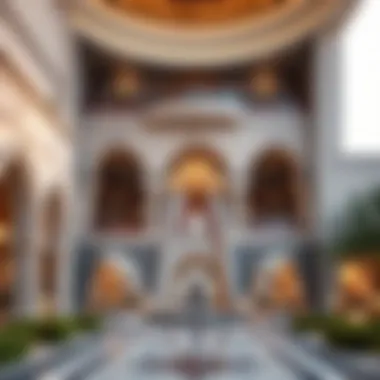
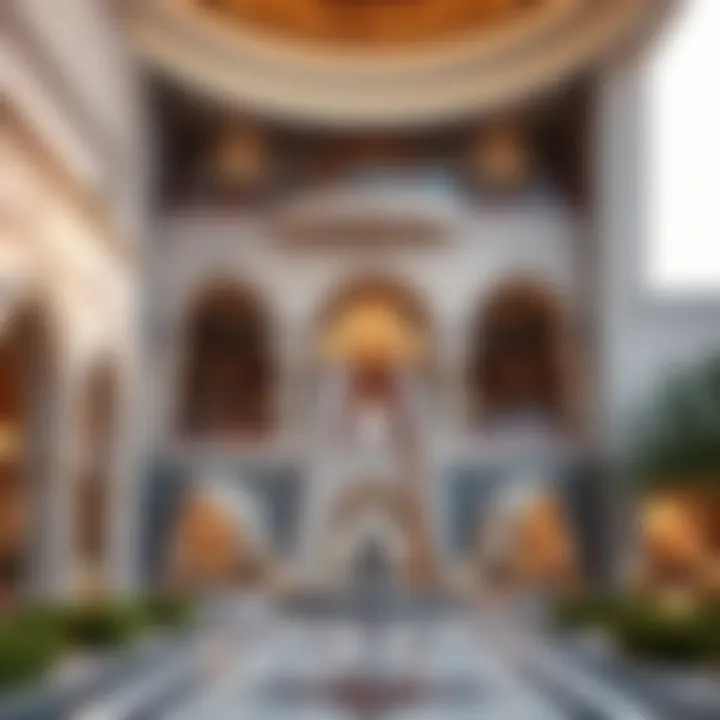
Intro
Nestled within the vibrant tapestry of Dubai, the Nad Al Sheba Palace stands as a testament to the city’s rich history and its rapid transformation. This architectural marvel mirrors the dual essence of Dubai—where tradition meets modernity. It acts as a silent guardian of the past, offering a glimpse into the cultural identity of the region, while also reflecting the ambitious growth the Emirate has undergone in recent decades.
Investors, real estate analysts, and history enthusiasts alike will find the palace an intriguing focal point. It does not merely serve a ceremonial purpose but rather carries profound implications for understanding the evolving real estate landscape in Dubai. The palace is surrounded by a plethora of emerging neighborhoods, each sporting tidbits of culture, economic potential, and lifestyle changes that influence property values.
In this exploration, we will dissect the significance of the Nad Al Sheba Palace, taking into account its architectural elements, historical importance, and impact on the local real estate market. From examining how it fits into Dubai's evolving story to understanding its role in shaping community identity, our journey reveals insights that can guide informed investment decisions and community building efforts.
Historical Background of Nad Al Sheba Palace
The Nad Al Sheba Palace stands as a testament to the rich history and culture of Dubai, serving not just as a royal residence but also as a significant landmark that reflects the past and present of the emirate. Understanding the historical background of this palace is crucial for grasping its architectural significance and its role in the broader narrative of Dubai's growth.
Origin and Construction
Nad Al Sheba Palace was built in the early 20th century, with construction starting around the 1970s, designed to serve the ruling family of Dubai. Its origin lies deeply rooted in the traditions of Emirati architecture, characterized by local materials and styles that reflect the region's climate and culture. The palace was constructed using sandstone, which is abundant in the area, lending not just durability but an authenticity that echoes the essence of Dubai's architectural roots.
The design incorporates elements typical of traditional Gulf architecture, such as high ceilings and expansive courtyards that are essential for ventilation in the hot climate. The layout of the palace is strategic, providing both privacy for the royal family and accessibility for state functions. This blend of functionality and aesthetics underscores the thoughtful planning that went into its development.
Notably, local craftsmen played a vital role in the construction, ensuring that the techniques and artistry were preserved. Through its evolution, the palace has stood witness to the transformations of the region, from a modest coastal settlement to a bustling metropolis.
Key Historical Events
Throughout the years, Nad Al Sheba Palace has been a backdrop for numerous pivotal events in Dubai's history. One of the significant events occurred in the early 80s when the palace hosted crucial gatherings aimed at shaping the future of the emirate amid rapid modernization.
In addition, the palace has welcomed various dignitaries from around the globe, further establishing its status as a center for diplomacy and high-profile discussions. Notably, significant cultural celebrations and festivals have taken place here, commemorating milestones that reflect the UAE's heritage and advancements.
In recent years, the palace has also embraced technology, incorporating modern amenities while respecting its historical integrity. This shift illustrates how the palace consistently adapts to the changing times, ensuring that it remains relevant in Dubai’s architectural landscape.
"Nad Al Sheba Palace is not just a historical building; it is a bridge between the past and the future of Dubai."
The significance of Nad Al Sheba Palace extends beyond its walls. It serves as a source of pride for the local community, symbolizing their cultural identity and resilience. Its historical narrative continues to evolve, making it a focal point for future developments and tourism in Dubai.
In summary, the historical background of Nad Al Sheba Palace reveals its foundational role in the emirate's story, teaching us about the intricate ties between tradition and contemporary progress.
Architectural Significance
The architectural significance of Nad Al Sheba Palace extends beyond its striking visual appeal. This space encapsulates a unique blend of traditional Arab design and cutting-edge modern elements, profoundly contributing to Dubai’s architectural narrative. Such significance can be unpacked by examining distinct design elements, the materials utilized in construction, and the cultural influences that have shaped its identity.
Design Elements
At first sight, the design elements of Nad Al Sheba Palace tell a narrative steeped in tradition yet resonating with contemporary trends. The palace features intricate geometric patterns, which are characteristic of Islamic architecture, standing as a testament to the region’s rich heritage. Tall arches and expansive courtyards invite natural light, creating an airiness and openness that contrasts with the often-crowded urban life outside.
Moreover, the interplay of symmetry and proportion in the layout reflects a keen attention to detail that is on par with global architectural standards. Every corner of the palace seems thoughtfully crafted, pointing to a meticulous process during its design and construction. The incorporation of fountains and gardens symbolizes the Islamic connection to nature and serenity, reinforcing its cultural grounding. With these elements, the palace doesn’t just serve a functional role; it evokes a sense of pride and belonging among locals.
Materials Used
When it comes to the materials used, Nad Al Sheba Palace is a showcase of opulence merged with sustainability. The structure employs traditional materials like sandstone and marble, emblematic of historical architecture, which not only echo the palace’s cultural significance but also bolster its structural integrity. Using such durable materials ensures that the palace withstands the test of time, maintaining its grandeur through the harsh desert climate.
Additionally, the contemporary touch can be found in modern insulation technologies and eco-friendly materials that enhance energy efficiency. This blend of old and new not only reinforces the palace’s aesthetic appeal but also signals a progressive mindset in architectural practices. In the realm of real estate and investment, such use of materials indicates a long-term vision, offering potential buyers and investors insights into the value of heritage combined with modern sustainability.
Cultural Influences
Finally, the cultural influences embedded within Nad Al Sheba Palace are profound. The design embodies the values and traditions of Emirati culture, representing unity and hospitality, which are deeply cherished in the region. Visitors often find that these cultural aspects create an inviting atmosphere, resonating with both locals and tourists alike.
Culturally, the palace stands as a symbol of the UAE's evolution, reflecting both historical traditions and modern aspirations. The influence of Bedouin architecture is apparent, with its emphasis on functionality yet artfulness, blending seamlessly into the surrounding landscape. This multi-faceted cultural narrative provides a rich context for property investors to understand the intrinsic value tied to local heritage.
In summary, Nad Al Sheba Palace is more than mere bricks and mortar; it is a living example of architectural achievement that bridges the past with the present. Its design elements, materials, and cultural influences coalesce into a structure that inspires both pride and investment.
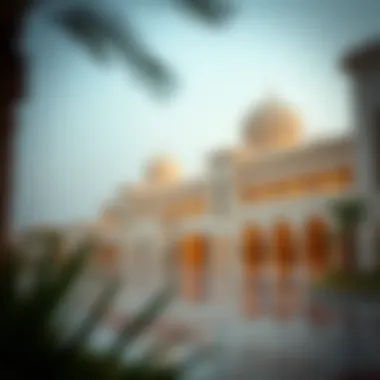
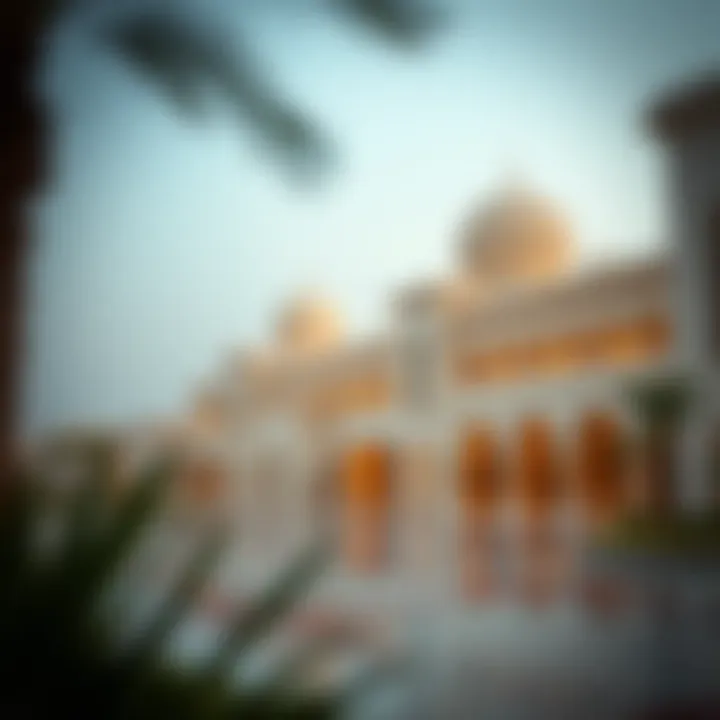
Nad Al Sheba in the Context of Dubai
The Nad Al Sheba Palace is more than just an architectural piece in the bustling city of Dubai. It represents the intricate weave of historical richness and contemporary progress, making it a touchstone for understanding Dubai's rapid evolution. The palace's presence has not only shaped its immediate surroundings but also contributed significantly to the cityscape's identity. Examining Nad Al Sheba within the broader context of Dubai unveils various critical aspects that influence real estate dynamics, cultural interactions, and social structures.
Evolution of the Surrounding Area
Over the years, the areas surrounding Nad Al Sheba have undergone remarkable transformation. Once a relatively quiet neighborhood reflecting traditional Emirati lifestyle, Nad Al Sheba has morphed into a thriving locale marked by modernity while still preserving echoes of its historical past. This evolution can be attributed to several key factors:
- Infrastructure Development: The establishment of major roads and transport links has opened up the area, connecting it seamlessly to bustling hubs like Downtown Dubai and Dubai Marina. This accessibility has made Nad Al Sheba an attractive option for both residents and investors.
- Urban Planning Initiatives: Strategic urban planning efforts aimed at sustaining growth in Dubai have led to the introduction of residential and commercial developments adjacent to the palace. This flux has helped infuse a fresh vibrancy to an already culturally rich area.
- Cultural Integration: The blend of new construction with existing heritage structures reflects an ongoing dialogue between past and present. Inviting cultural events and exhibitions are staged in and around the palace, shining a spotlight on the convergence of old traditions and new customs.
Impact on Local Community
The Nad Al Sheba Palace is not merely a historical landmark; it functions as a nucleus for community cohesion and engagement. Its influence on the local populace is palpable through various facets:
- Cultural Significance: The palace serves as a venue for national celebrations and cultural events, fostering unity among residents. Such gatherings invite individuals from different backgrounds, shaping a society that's diverse yet connected.
- Economic Contributions: As the surrounding area develops, local businesses gain a boost. Cafes, boutiques, and recreational facilities are springing up, providing job opportunities and enhancing the quality of life for residents.
- Community Identity: The palace contributes to the local identity, reminding people of their heritage while embracing new influences. It stands as a symbol of pride, giving residents a sense of belonging in a fast-paced environment.
As Nad Al Sheba Palace continues to be a focal point for both tradition and modernity, it embodies the spirit of Dubai—thriving with opportunity while deeply rooted in its rich cultural landscape.
Modern Amenities and Usage
The Nad Al Sheba Palace stands not only as a monument of history and tradition but also as a beacon of modernity, catering to contemporary needs and aspirations. In today’s fast-paced world, the blend of traditional architecture with cutting-edge amenities sets this palace apart as a living entity rather than just a remnant of the past. Understanding the modern amenities and usage within the palace is crucial for potential investors and community members alike, as this fusion reflects a deeper narrative about and around the palace and its influence in Dubai.
Current Roles and Functions
The palace serves multiple pivotal roles in both governance and cultural representation. It is not just an isolated structure; rather, it functions as the administrative center for several governmental activities. Key personnel, including high-ranking officials, utilize the palace for discussions state matters and planning initiatives, which speaks volumes about its strategic significance.
Additionally, Nad Al Sheba Palace takes on a more ceremonial role during cultural events and national holidays. It stands as a backdrop where tradition harmonizes with the innovations of modern ceremony. The site where significant events unfold—from royal receptions to community festivals—helps reinforce its relevance as a bridging point for both the contemporary populace and those steeped in historical narratives.
- Roles include:
- Administrative functions for local governance.
- Venue for national and cultural celebrations.
- A symbol of unity among the community.
Event Hosting and Cultural Functions
As we dive deeper into the cultural significance of Nad Al Sheba Palace, it becomes clear that this is not just a place of traditions; it's also a lively hub for a multitude of events that showcases Dubai's rich heritage. The palace hosts international delegations, official state visits, and cultural gatherings that aim to retain and promote local traditions, thereby enhancing community identity.
Modern amenities complement these activities, ensuring that guests experience a seamless blend of luxury and service that is expected in today’s hospitality landscape. State-of-the-art catering facilities, advanced audiovisual technology, and luxurious event spaces play a crucial role in ensuring that every cultural event is memorable and engaging.
"The palace acts as both a gallery of history and a stage for the future, hosting events that keep traditions alive while embracing modernity."
Moreover, with its galleries and exhibition spaces, Nad Al Sheba Palace serves as a platform for artists and local craftsmen, showcasing their work. This not only amplifies cultural awareness but also provides a nurturing ground for budding talents eager to connect with their heritage.
- Cultural functions include:
- Art exhibitions focusing on local talent.
- Traditional performances that attract both locals and tourists.
- Workshops aimed at educating the community on traditional crafts.
In summary, the Nad Al Sheba Palace thrives as a multi-functional space where tradition meets modernity. Potential investors would do well to consider how current roles and functions enhance not just the palace's value, but its significance within the broader communal narrative.
Property Investment Insights
Understanding the real estate potentials surrounding the Nad Al Sheba Palace is more than mere numbers and graphs; it’s about grasping the intricacies of a vibrant area rich in culture and heritage. The Nad Al Sheba area has become a focal point for investors due to its unique blend of traditional aesthetics and modern conveniences. Knowing how the palace influences investment decisions can provide a roadmap for prospective buyers and seasoned investors alike.
Market Trends in Proximity to Nad Al Sheba
The market just around the Nad Al Sheba Palace is like a simmering pot ready to boil over. With the palace's stature as a hallmark of architectural beauty, the demand for property in this area has recently witnessed an upward trend. The sights are set on urban centers like Nad Al Sheba as they continue to blossom into dynamic communities where modern lifestyles thrive with an undercurrent of tradition.
- Increasing Accessibility: Major road networks and public transport options are sprouting up like daisies. The proximity to major arterial roads means quick access to downtown Dubai and other business hubs, capturing the attention of those looking for a residence that’s connected yet serene.
- Shift Towards Mixed-Use Developments: Developers have taken the cue from these trends. New residential and commercial partnerships are popping up, crafting an attractive landscape for families and businesses alike. Think local cafés and artisanal shops infused into residential complexes—this is the kind of magic happening in Nad Al Sheba.
- Rise in Luxury Condominiums: With an increasing affluent demographic, luxury living options are piquing interest. High-end condominiums and villas that echo the grandeur of the palace itself have entered the market, promising high returns for those willing to stake their claim.
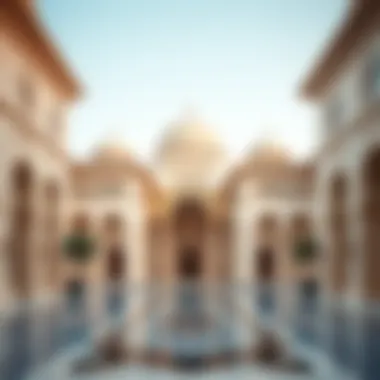
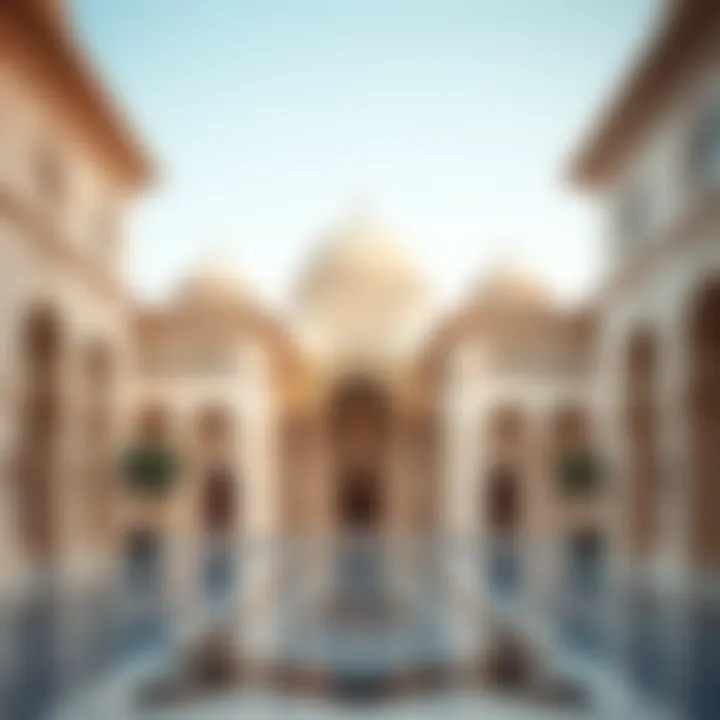
The above factors highlight not just the viability but the potential growth sources for investors eyeing this location. Fortunes are waiting to be made for those who jump in at the right time.
Impact on Local Real Estate Value
When it comes to real estate values, in the shadow of a cultural gem like the Nad Al Sheba Palace, it's clear that heights can be reached. The influence of such an iconic landmark extends far beyond its walls and into the very fabric of the local housing market.
- Increased Property Valuation: Properties within close proximity to the palace often fetch higher prices compared to those farther away. The palace contributes not only to aesthetic appeal but also symbolizes prestige. Families want to live in areas that showcase such historical significance.
- Stability in Investment: Investing near established landmarks fosters a sense of security. There’s an inherent stability in property values when major attractions are within arm's reach. People are more likely to invest significantly, knowing the area offers lasting allure and cultural resonance.
- Community Development: Areas surrounding the palace are experiencing gentrification, leading to enhanced community infrastructure. Parks, retail spaces, and educational institutions are on the rise, making these locations increasingly desirable. The newer properties are attracting a diverse range of buyers, forging a tight-knit community that appreciates both modernity and history.
"A landmark like Nad Al Sheba Palace is not just a symbol; it's a catalyst for growth and innovation in the local real estate sphere."
Future Developments Around the Palace
The Nad Al Sheba Palace stands as a testament to Dubai's blending of rich history with modern innovation. The future developments surrounding this architectural gem are of crucial significance, not just for the palace itself but for the entire region. These developments reflect the city's commitment to progress while preserving its cultural heritage. For property investors and stakeholders, the landscape around the palace is evolving into one where new opportunities are ripe for exploration.
Planned Infrastructure Improvements
Infrastructure improvements in the vicinity of the Nad Al Sheba Palace are set to play a key role in revamping the area. Key updates in transportation and public amenities can enhance accessibility, making the palace a prime spot for both tourists and local residents.
- Road Connections: Enhancements to existing roadways and the addition of new routes will facilitate easier access to and from the palace, connecting it with other pivotal areas of Dubai.
- Public Transport Expansion: Development of nearby metro stations or bus routes can elevate visitor numbers, promoting tourism as well as local interests.
- Green Spaces: Plans for new parks and recreational areas nearby aim to provide a balance to the urban environment, offering relaxing spots for families and tourists alike.
These changes will be vital in ensuring that the Nad Al Sheba Palace remains a cultural magnet for years to come, helping to bridge the gap between traditional allure and modern functionality.
Potential Real Estate Projects
Real estate projects planned near Nad Al Sheba Palace present compelling prospects for investors. The momentum for growth created by infrastructure improvements can lead to:
- Residential Developments: With demand continuously on the rise, new residential complexes may be on the drawing board. These can cater to a range of buyers, from luxury condos to affordable housing, thus attracting a diverse population around the palace.
- Commercial Spaces: Businesses looking to tap into the tourist influx could find new office spaces or retail opportunities sprouting up, further adding to the local economy.
- Mixed-Use Developments: These projects integrate living, working, and recreational amenities, which could transform the way locals and visitors interact with the area, making it a lively cultural hub.
As the fabric of the Nad Al Sheba landscape changes, investors should keep a close eye on developments unfolding in this vibrant part of Dubai. The emergence of such projects will not only influence property values but also mold community identity, enriching the overall experience around this historic palace and its surroundings.
Tourism and Cultural Significance
Nad Al Sheba Palace holds a distinctive position within Dubai's tapestry of heritage, merging the city's rich history with present-day aspirations. It's not merely an architectural marvel; it symbolizes cultural pride, attracting visitors from across the globe. For investors and real estate enthusiasts, understanding the significance of tourism and culture in the context of this landmark becomes essential, as these elements directly influence property values and community identity.
This palace serves as a beacon of heritage, reminding the locals and tourists alike of the roots from which modern Dubai has sprung. A tangible representation of Emirati culture, it encourages a deeper appreciation of local customs and traditions. The rich narrative embedded within its walls fosters an environment conducive to learning and exploration, thus enhancing the allure for tourists.
Visitor Engagement and Accessibility
The accessibility of Nad Al Sheba Palace significantly contributes to its tourism appeal. Nestled in a strategic location, the palace welcomes visitors not just from the region but from all corners of the world. Several initiatives have been implemented to ensure that people can easily experience its grandeur.
For instance, guided tours are organized frequently, allowing visitors to navigate the intricacies of its design and profound historical context. The paths leading to the palace are well-maintained and thoughtfully planned, making it a breeze to reach without needing to navigate through complex local routes.
Moreover, the integration of digital platforms offers virtual tours for those unable to visit in person. Such innovations enhance engagement, enabling a broader audience to connect with the site, even from thousands of miles away.
Here are some key engagement initiatives that bolster visitor interaction:
- Interactive guided tours, which provide in-depth knowledge through firsthand narrative.
- Community events and workshops held in the palace grounds, encouraging local participation.
- Online resources, including virtual tours that help keep the palace's spirit alive even remotely.
Cultural Heritage and Education
The educational aspect of Nad Al Sheba Palace cannot be overlooked. The significance of cultural heritage resonates throughout the site's architecture and historical narratives, offering myriad educational opportunities. Schools and educational institutions frequently organize field trips, allowing students to absorb knowledge about their heritage first-hand. The connection made between youth and their history plays a crucial role in fostering a sense of identity and continuity.
Additionally, workshops focusing on Emirati art forms and storytelling are conducted regularly, promoting intercultural dialogue and understanding. These initiatives help the palace transcend its physical boundaries, transforming it into a living classroom.
Key educational benefits provided by the palace include:
- Cultural workshops that explore traditional crafts and storytelling.
- Exhibitions showcasing local history, art, and innovations.
- Collaborations with schools and universities to promote knowledge sharing.
Preservation Efforts
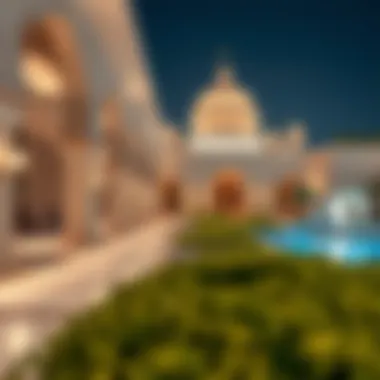
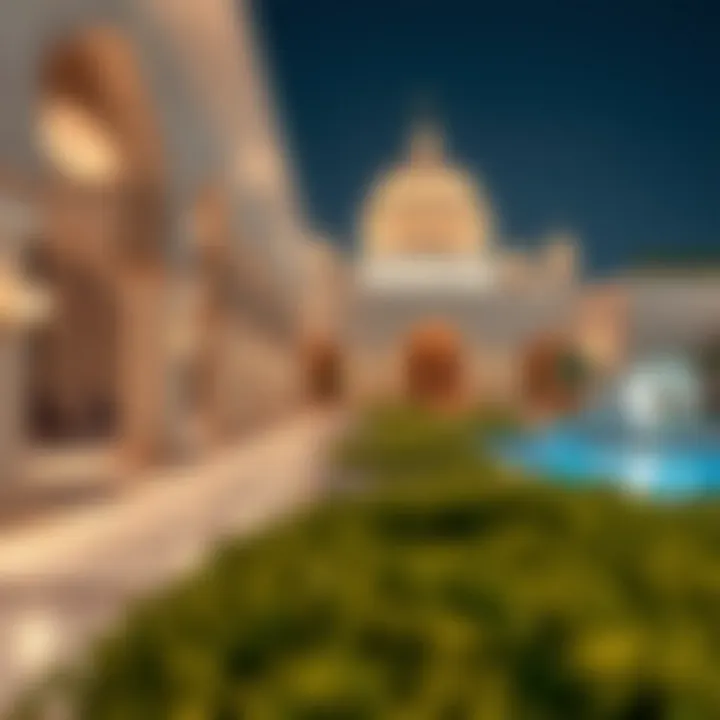
Preserving the Nad Al Sheba Palace is an essential endeavor, intricately tied to maintaining Dubai’s cultural heritage and architectural identity. This palace represents not just a physical structure, but a tapestry of history that contributes to the narrative of the region's evolution. Its preservation underscores the community's commitment to honoring its past while thoughtfully integrating modern principles.
“Without preservation, history fades, and so does our identity.” This saying resonates profoundly within the context of the Nad Al Sheba Palace. As a landmark imbued with rich tradition, it serves various purposes beyond mere aesthetics—its walls echo tales of the past, shaping the present and influencing the future.
Key elements of preservation efforts involve detailed restoration initiatives and fostering community involvement. By prioritizing these areas, stakeholders ensure that the palace remains a living part of Dubai’s story while adapting to contemporary needs and expectations.
Restoration Initiatives
Restoration initiatives seen at Nad Al Sheba Palace comprise both practical and aesthetic endeavors aimed at maintaining the integrity of the structure. Notably, restoration involves meticulous work on architectural features that may have weathered over time. These efforts ensure that original designs are upheld, and any necessary upgrades are sensitively integrated, so historical authenticity remains intact.
Understanding the historical significance of intricate carvings or glazed tiles can guide the process of restoration. Upkeep tasks may include:
- Repointing masonry and securing the foundation to prevent decay.
- Using traditional techniques to restore decorative elements without compromising their design.
- Updating modern amenities while respecting the original architectural style.
By committing to such initiatives, the Nad Al Sheba Palace not only upholds its aesthetic but also serves as a testament to the craftsmanship of its era.
Community Involvement
Community involvement is a cornerstone of preserving the Nad Al Sheba Palace. Engaging local residents, schools, and cultural organizations fosters a sense of ownership and pride in their heritage. Such initiatives can manifest in various forms, including:
- Awareness Campaigns: Programs designed to educate the public about the history and significance of the palace, aiming to rekindle local interest and involvement.
- Volunteering Opportunities: Local residents often contribute to restoration projects through volunteering, bringing a deep-seated connection and investment in the palace's future.
- Cultural Events: Hosting events that celebrate local culture, such as art exhibitions or traditional festivals, creates avenues for community interaction while emphasizing the palace as a cultural focal point.
Through these collaborative efforts, the palace transcends its physical space, evolving into a living museum that not only narrates history but dynamically engages the community for generations to come.
In preserving the Nad Al Sheba Palace, stakeholders not only secure the architectural and historical value of the site but also reinforce community ties, establishing a harmonious blend of tradition and modernity—not just in bricks and mortar, but in the very culture of Dubai.
Comparative Analysis with Other Landmarks
A comparative analysis of landmarks offers valuable insights into their individual essence and significance. Examining Nad Al Sheba Palace in the context of similar structures enables visitors and researchers to better appreciate its unique architectural language and heritage. This approach not only highlights the distinguishing features of the Nad Al Sheba Palace but also positions it within the broader narrative of Dubai's evolving identity.
Nad Al Sheba Palace vs. Sheikh Mohammed's Palace
Both Nad Al Sheba Palace and Sheikh Mohammed's Palace serve as emblematic representations of Dubai’s culture and political landscape. Each landmark, while echoing the other in terms of grandeur, showcases distinct architectural styles and historical narratives.
- Scale and Design: While Sheikh Mohammed’s Palace captivates with its sprawling grounds and more contemporary aesthetics, Nad Al Sheba Palace integrates traditional motifs, making it a key identifier of Arabian architecture. The intricate designs of Nad Al Sheba reflect a pride in Emirati craftsmanship that resonates through the ages.
- Historical Relevance: Nad Al Sheba Palace, with its foundation dating back decades, holds memories of significant historical events that have shaped not just Dubai but the greater UAE. Conversely, Sheikh Mohammed's Palace often serves as a site for more contemporary governmental functions and high-profile events, thus giving it a role rooted more in current events rather than historical legacy.
- Community Engagement: The engagement level at both locations also varies. Nad Al Sheba Palace remains a cultural beacon for local traditions, often featuring events that spotlight Emirati culture. Sheikh Mohammed's Palace, while also showcasing culture, gravitates more towards state functions and international diplomacy.
Unique Features Compared to Other Historical Sites
Some of the most captivating qualities of Nad Al Sheba Palace become apparent when viewed against other historical jewels within Dubai and beyond.
- Architectural Fusion: The blend of traditional and modern design elements illustrates how heritage can coexist with contemporary functionality. It is unlike landmarks such as the Al Fahidi Historic District, which embraces a more homogenous cultural style.
- Functionality and Heritage: Unlike the Burj Khalifa, which is predominantly a symbol of modernity, Nad Al Sheba maintains its historical significance while also serving modern-day needs, thus creating a unique dual identity.
- Cultural Symbols: Elements like intricate tilework and expansive courtyards at Nad Al Sheba offer a glimpse into the craftsmanship of a bygone era, distinguishing it from the more commercially-driven sites within Dubai’s touristic areas.
In essence, examining Nad Al Sheba in this comparative light not only emphasizes its importance but also enriches the visitor's understanding. Thus, real estate investors and cultural enthusiasts alike stand to gain much by exploring its depths—and appreciating the subtle yet impactful contrasts it holds against its prominent landmarks.
The Ends and Implications
As we draw the curtain on the exploration of Nad Al Sheba Palace, it’s vital to understand the broader implications of this remarkable structure within Dubai's architectural landscape. The palace serves not just as a residence but as a living museum that juxtaposes tradition with modernity, merging historical gravitas and contemporary design in ways that reflect the evolution of urban spaces in the emirate.
Nad Al Sheba Palace as a Case Study
Studying Nad Al Sheba Palace provides a lens through which the confluence of cultural identity and architectural innovation is observed. For investors and real estate analysts, the significance of this palace is twofold.
Firstly, it demonstrates how historical sites can enhance the attractiveness of nearby property developments. These sites anchor communities by providing a sense of belonging and continuity, fostering a unique cultural narrative. Investment in areas surrounding Nad Al Sheba has shown positive correlations with property values, where cultural significance adds a premium to the real estate market.
Secondly, it showcases urban development that respects the historical fabric of society. The architecture is not just bricks and mortar; it’s a symbolic representation of the societal values that residents hold dear. By preserving such legacy while enabling modern functionality, the palace stands as a prime example for architectural projects aimed at revitalizing historical areas.
Future Directions for Research and Exploration
Looking forward, there is vast potential for further exploration of the Nad Al Sheba Palace as a pivotal point for research in urban studies and architecture. Areas of interest could include:
- Sustainability Initiatives: How does the palace integrate sustainable practices with its traditional architecture? Is there potential for more eco-friendly upgrades?
- Cultural Events Impact: What role do cultural events held in and around the palace play in community engagement? This could be evaluated through surveys and visitor patterns.
- Architectural Heritage: How does Nad Al Sheba Palace compare to other historical landmarks in Dubai and beyond? Understanding its uniqueness can inform future designs and restoration projects.
"Understanding landmarks like Nad Al Sheba Palace is crucial for addressing the needs of growing urban populations while honoring historical contexts."
For a more detailed view on urban architecture, you might explore resources like Britannica or Wikipedia.







